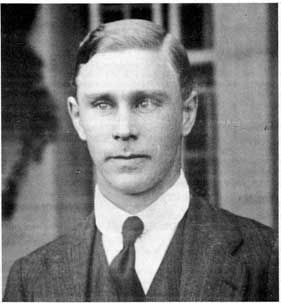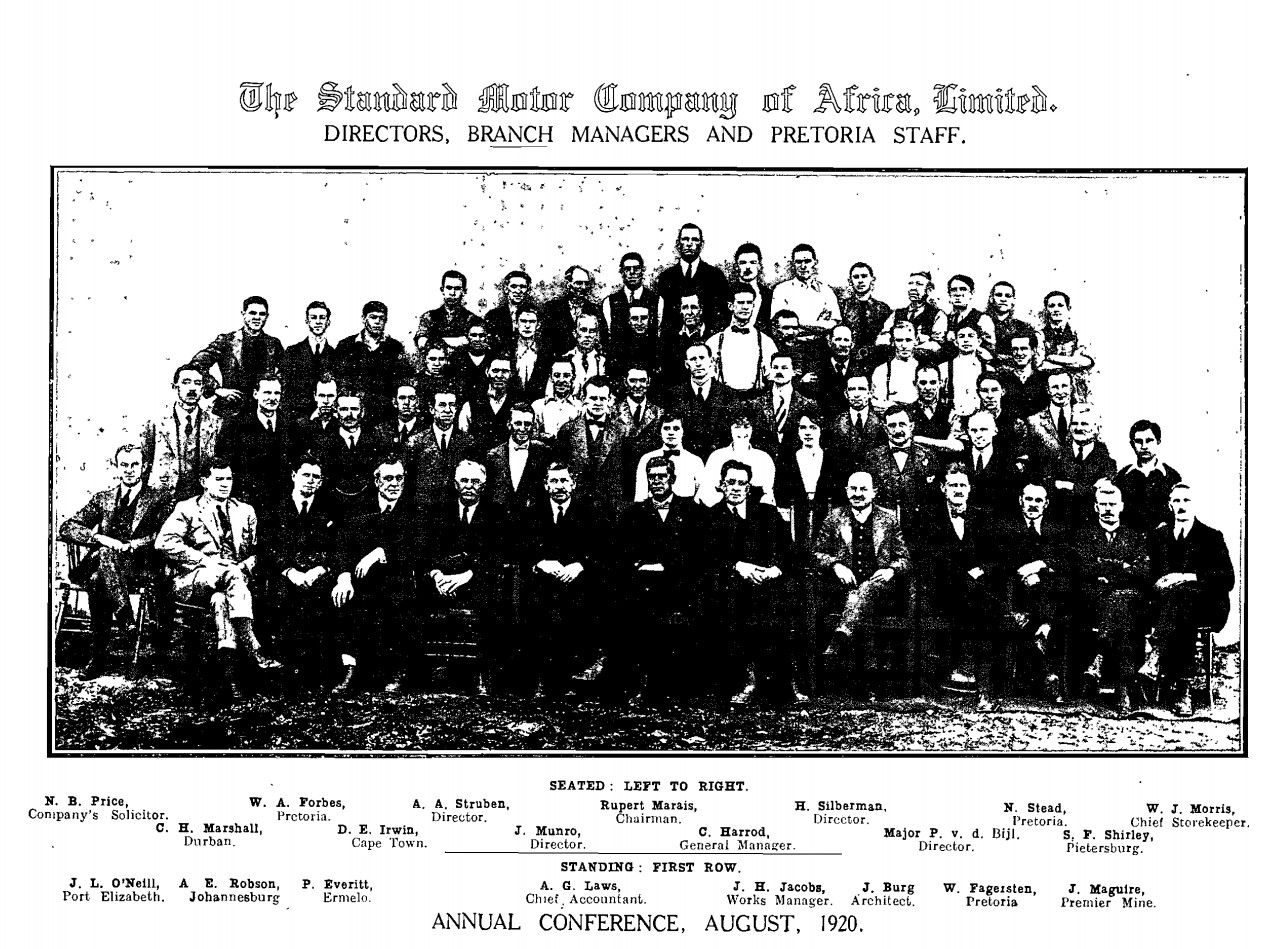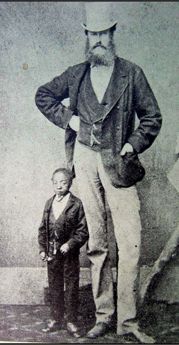Rupert Ford Marais

The Marais family in South Africa dates back to the arrival of Charles Marais, a French Huguenot immigrant, in 1688. Rupert was born on a farm known as Nektar, near Stellenbosch. He was a 6th-generation descendant of Charles Marais. Authors Eugene Marais (cousin) and Joy Packer (niece - her mother was Rupert's sister Ellen) were members of this branch of the extended Marais family. Melt Marais, former commander of the Pretoria garrison during the Boer War was also a cousin.
His father, Petrus Jacobus Marais, was a colourful character known as Lang Piet, on account of his being known as the tallest man in Pretoria. He was worth nine million pounds from gold prospecting in the Transvaal. Rupert was born in Pretoria, where his father owned the first double-story building in town, known as Nigel House. His gold fortune was due to finding gold on his farm, which later became the town of Nigel. Lang Piet later returned to the Cape, where he lived at Wheatfields in Mowbray.
The story of Rupert Marais, the swimmer, remains untold. Although he did graduate from UCT in 1901, it's unknown where he grew up, went to school, and when he moved from Pretoria to the Cape. The Claremont indoor swimming pool must have been near the Wheatfield house, although it is not known whether Lang Piet Marais built the home or if the children all went to school in the area.
The Marais family name - Rupert, his brother George, and a P. Marais - appears in the newspaper reports of swimming in the Cape between 1898-1902. Rupert won the 220-yard Western Province Championship in January 1899. The Team Race, where he swum for the Leander SC, and where a P. Marais was listed as a reserve. It is unclear how the Marais children returned to the Cape, and became involved with the Leander Swimming Club.
His brother Charles Marais also played water polo for Western Province, winning the Currie Cup in 1901.
Rupert was born in Pretoria in 1880 and died there on 1 August 1924. He married Stella Felicia Emmett in St Peter's Church in Vryheid, Natal, on 5 October 1905. Stella passed away in Pretoria on 11 November 196. Her sister Venetia, married Charles Marais, another brother of Rupert Marais, in Vryheid on 5 October 1893. She also lived in Pretoria until she passed in 1954.
In June 1901, he passed the Law Certificate Examination at the University of Cape Town, and by 1902, he was practising as an attorney in Pretoria. Rupert Marais was joined by Norman Price (later to become Judge N. C. B. Price) and Charles William Clark, and the firm became known as Marais Price and Clark. Both Rupert and Norman Price were on the Board of Directors of the Standard Motor Company of Africa, where Rupert was also the Chairman.


In the year 1882 a farmer Petrus Johannes Marais (nicknamed Oom Lang Piet) who owned the farm Varkensfontein in the Heidelberg district made an agreement with a prospector named Johnstone allowing him to prospect for gold on the farm Varkensfontein.
Mr. Johnstone' s prospecting operations continued for a considerable time shrouded in secrecy.
Then one day a stranger turned up at Oom Lang Piet's home and made an offer to buy the farm.
At the time of the offer Oom Lang Piet was by chance busy reading "The Fortunes of Nigel" by Sir Walter Scott, a story about a young man who was the victim of a dishonest intrigue but eventually achieved his goal in life
The stranger's visit immediately aroused Mr. Marais's suspicions to the extent that he decided to visit his farm himself.
https://www.nigel.co.za/history.htm
In 1882 a farmer Petrus Johannes Marais (nicknamed Oom Lang Piet who owned the farm Varkensfontein in the Heidelberg district) made an agreement with a prospector named Johnstone, allowing him to prospect for gold on the farm Varkensfontein.
Johnstone’ s prospecting operations continued for a considerable time shrouded in secrecy until a stranger turned up at Oom Lang Piet’s home and made an offer to buy the farm. At the time, Marais was reading “The Fortunes of Nigel” by Sir Walter Scott (a story about a young man who was the victim of a dishonest intrigue but eventually achieved his goal in life).
The stranger’s visit immediately aroused Marais’s suspicions to the extent that he decided to visit his farm himself. Once at the farm, he found that his suspicions were well founded.
With the experiences of the character in the novel in mind, he determined not to allow himself to be cheated by cunning fortune seekers and at once set about to establish his own company. In July 1888 (two years after the discovery of gold on the Witwatersrand) Marais achieved his goal.
Marais attributed his luck to the novel he had been reading and therefore, called his company Nigel (after the character in the novel) and in this way, the town of Nigel came into being. In 1888 the state president Paul Kruger declared Nigel as a public digging under notice 331 and since then the history and development of Nigel are inseparable from those of the gold mines.
Once at the farm he found that his suspicions were well founded.
With the experiences of Nigel, the character in the novel in mind, he determined not to allow himself to be cheated by cunning fortune seekers and at once set about to establish his own company.
In July 1888, two years after the discovery of gold on the Witwatersrand, he achieved his goal.
Marais attributed his luck to the novel he had been reading and, therefore, called his company Nigel. In this way, the town of Nigel came into being.
Heavy Rainstorms in Pretoria
9 Maart 1886
On Saturday afternoon one of the most terrible downpours we have ever witnessed in Pretoria took place. The weather had been rainy all that week and on Tuesday evening a hailstorm raged in the direction of Magaliesberg, part of which approached the city in the northern direction. On Wednesday afternoon a violent windstorm came from the east, which drove up mountains of dust and lashed people free from thunder, which ended in a refreshing rain, which continued for a while. On Thursday the sky was more or less cloudy, but it did not rain. On Friday morning and also on Saturday morning there were beautiful rains, but on Saturday afternoon we had a miniature deluge. It started to rain just after 5 o'clock and for almost two hours there were continuous streams of rain, something like a waterspout [garden hose]. The streets soon turned into rivers, which at some points were downright dangerous to cross. People caught in the rain had great difficulty in finding shelter due to the heavy downpour and the streams of water that flowed through the streets.
The Aapies River came down as if it were a mighty torrent, roaring like the bulls of Bashan. There was an extraordinary quantity of water in it, such as has not been seen in its bed for twelve or fourteen years. In one of its tributaries a couple of persons narrowly escaped death in the water. Mr. Kuranda took Mrs. Rex in his spider, drawn with two horses, to that other side of the river to spend the evening with another lady. He got over the bridge that leads to the "Lovers Walk" clearly, but no sooner was he on the other side than the violent current carried his spider and horses off, and he and Mrs. Rex had to seek shelter each in a tree.
Mr. Melt Marais, brother of Mrs. Rex, heard cries of fear in the lane of the "Lovers Walk", undressed hastily and jumped into the water. When he came to the spider he found no one in it and feared the worst, but when he called out he was very glad to find that Mrs. Rex and Mr. Kuranda were each safe on a tree. Mr. Kuranda's "Black Boy" who had clung to a wheel of the spider, fortunately had a razor in his pocket. With this Mr. Marais cut the horses loose, which immediately swam out of the water. Then he first rescued his sister and then helped Mr. Kuranda out of his dangerous position. That spider was tied to a tree and taken out the next morning. It was fortunate that Mr. Marais, a strong and muscular young man, was nearby, because otherwise at least the horses would certainly have been drowned, while it is impossible to say what would have been the fate of Mrs. Rex, Mr. Kuranda and the "Black".
On the map of Van Vooren and Oerder from 1889 we see that there are two bridges over the Apies River. One is in Kerkstraat and the other is where Maré and Rissik street join together. It is the latter bridge that is in question here.
Melt Marais [1860 – 1916] Kom in 1868 saam met sy gesin na Pretoria en vestig hom op die plaas wat later Les Marais sou heet. Hy was ‘n ouer broer van die digter Eugene Marais. Sy beroep was die van makelaar en algemene agent in vennootskap met Kuranda en later, nadat die vennootskap verbreek is, ook op sy eie. Melt Marais word ook gekies as Veldkornet vir Pretoria en het as sodanig ‘n leidende rol gespeel in die verset teen die Engelse. Melt Marais was definitief ‘n “sterk en gespierde jongmens”. In 1976 word ‘n sportdag gehou om President Burgers se verjaarsdag te vier. Melt Marais, toe 16 jaar oud, wen die 150 yards en ook die hoogspring vir seuns met ‘n hoogte van 3 voet 10 duim [De Volksstem, 29 April 1876].
https://repository.up.ac.za/bitstream/handle/2263/18407/Pta%2012-03.pdf?sequence=1&isAllowed=y
News - Toeka se dae |
|
| Monday, 19 August 2024 10:00 | |
|











